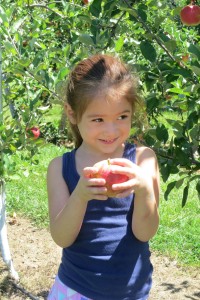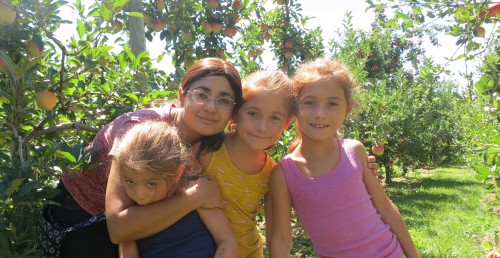 “Mrs. Gorf had a long tongue and pointed ears,” which she used to turn innocent children into apples.
“Mrs. Gorf had a long tongue and pointed ears,” which she used to turn innocent children into apples.
We meet this monstrous teacher in the first chapter of Louis Sachar’s Sideways Stories from Wayside School, a book my children love.
Most recently, we listened to the audio version of this book on our way home from our favorite apple orchard.
My girls giggled as usual at how long it took another teacher at Wayside School to realize the truth about Mrs. Gorf:
“Louis, the yard teacher… had heard that Mrs. Gorf was a mean teacher. So he came up to investigate. He saw twelve apples on Mrs. Gorf’s desk. ‘I must be wrong,’ he thought. ‘She must be a good teacher if so many children bring her apples.’”
“But,” my girls called out, “the children ARE the apples!”
Then, a little later, one of my rising second graders wondered, “Why does Louis, the yard teacher, think a kid would bring their teacher apples? I’ve never given my teacher an apple. Have you?”
No, I haven’t.
Nevertheless, I’ve always associated teachers with this fruit. Why is that? How did apples become a traditional gift to give to teachers?
I suspected it had something to do with the biblical Tree of Knowledge, which has often been depicted as an apple tree.
Then I came across an article in Smithsonian Magazine, Why Do Students Give Teachers Apples and More from this Fruit’s Juicy Past, which said:
“[T]eachers, particularly on the frontier, frequently received sustenance from their pupils. ‘Families whose children attended schools were often responsible for housing and feeding frontier teachers,’ according to a PBS special, titled ‘Frontier House, Frontier Life.’ An apple could show appreciation for a teacher sometimes in charge of more than 50 students.
Apples continued to be a favorite way to curry favor even after the practical purpose of feeding teachers disappeared. Bing Crosby’s 1939 ‘An Apple for the Teacher,’ explains the persuasive allure of the fruit. ‘An apple for the teacher will always do the trick,’ sings Crosby, “when you don’t know your lesson in arithmetic.”
It seems that, at least when it comes to books, giving an apple to the teacher to curry favor was a 20th century innovation, one that Crosby had a big hand in promoting. According to the Google Books Ngram Viewer, the phrases “apple for the teacher” and “teacher an apple” (as in, “gave the teacher an apple” or the like) were virtually nonexistent until 1925, and then soared in popularity after 1939.
So, there we have it.
I don’t know yet if my children will walk into school next week with a juicy apple for their new teachers, but I have to find something to do with the 50 pounds of Gala and Sansa apples we just brought home.
_________________________________________________________
*For more on apples and books, see The Prophetic Properties of Apples & An Apple (Or Two) A Day
*For what looks like a perfect “Apple Day” cake (I haven’t tried it yet, but I will!), see this recipe from Chew Out Loud.


Oh gosh my kids love Louis Sachar, too…. the kids are the apples – ha! Lovely investigation of the story behind apples for teachers… with supermarkets & modern agriculture I think we often forget how rare and precious a gift a simple piece of fruit once was (and maybe still should be!) Will appreciate our apples a little more today. And such happy pics!
“With supermarkets & modern agriculture I think we often forget how rare and precious a gift a simple piece of fruit once was (and maybe still should be!)”
Well said! Louis Sachar’s books are wonderful. “Holes” is my twins’ favorite one, but they love all of his books.
Your daughter loves that apple! It’s an excellent photo.
Thank you!
Cute story. I never gave an apple either. That is an adorable photo of the three of you too.
I did mean four of you.
Thank you! My kids didn’t end up bringing apples to school for their teachers, but we might give chocolate covered ones around the holidays. We’ll see!
That Louis is such a gem. Those books are great. Who reads the audiobook?
I have received two apples so far from my students after 3 years of teaching.. a glorious chocolate one, and a normal one, which to be honest kind of grossed me out since it seemed like it had been at the bottom of a fifth graders book-bag for a couple of days.